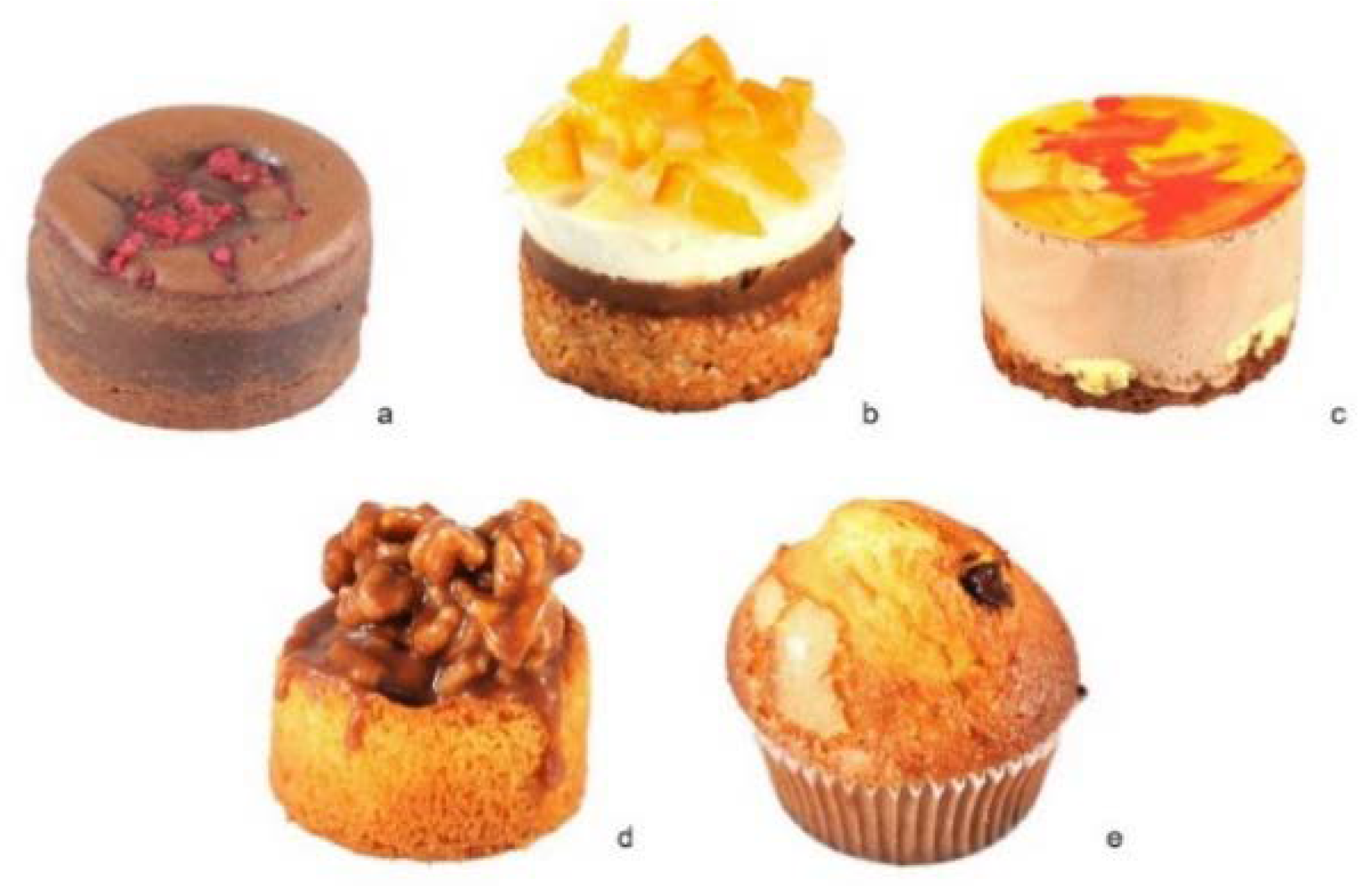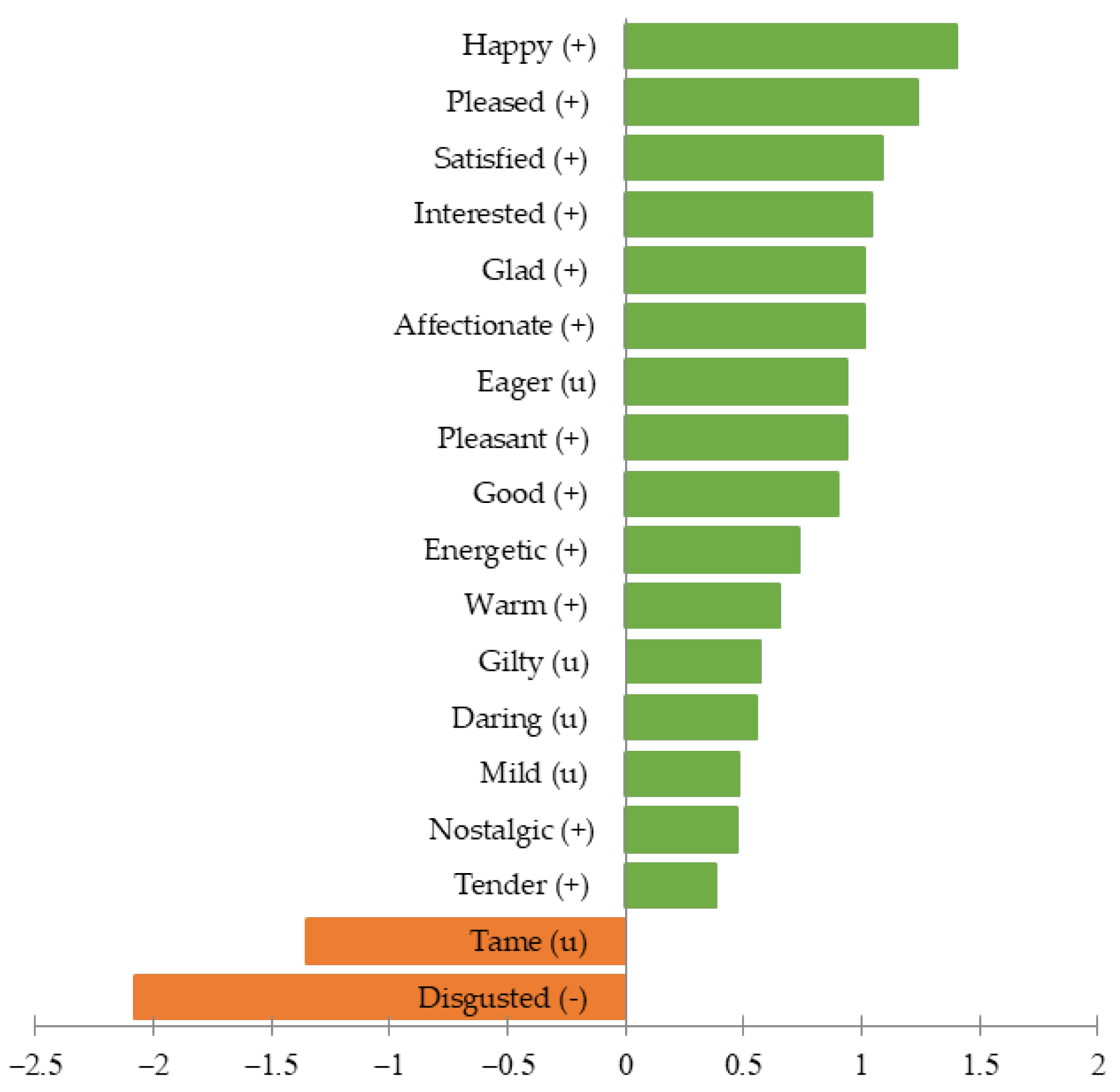Emotional Response to Different Types of Cakes through Visual Assessment †
Abstract
:1. Introduction
2. Materials and Methods
2.1. Stimuli
2.2. Participants
2.3. Questionnaire
2.4. Statistical Analysis
3. Results and Discussion
3.1. Emotional Profile after Visual Evaluation
3.2. Visual Acceptance and Willing to Buy
4. Conclusions
Author Contributions
Funding
Institutional Review Board Statement
Informed Consent Statement
Data Availability Statement
Acknowledgments
Conflicts of Interest
References
- Stierand, M. Culinary Creativity, 3rd ed.; Elsevier: Amsterdam, The Netherlands, 2016; Volume 1, ISBN 9780128093245. [Google Scholar]
- Martínez-Monzó, J.; García-Segovia, P.; Albors-Garrigos, J. Trends and innovations in bread, bakery, and pastry. J. Culin. Sci. Technol. 2013, 11, 56–65. [Google Scholar] [CrossRef]
- Albors-Garrigos, J.; Barreto, V.; García-Segovia, P.; Martínez-Monzó, J.; Hervás-Oliver, J.L. Creativity and innovation patterns of haute cuisine chefs. J. Culin. Sci. Technol. 2013, 11, 19–35. [Google Scholar] [CrossRef]
- Albors-Garrigós, J.; Martinez Monzo, J.; Garcia-Segovia, P. Knowledge dynamics as drivers of innovation in Haute Cuisine and culinary services. Ind. Innov. 2017, 25, 84–111. [Google Scholar] [CrossRef]
- Laska, M.; Freist, P.; Krause, S. Which Senses Play a Role in Nonhuman Primate Food Selection? A Comparison between Squirrel Monkeys and Spider Monkeys. Am. J. Primatol. 2007, 69, 282–294. [Google Scholar] [CrossRef] [PubMed]
- Gomes, A.; de Azevedo, M.L.; Gomes, A. El sistema de oferta de restaurantes de alta gastronomía. Estud. Perspect. Tur. Vol. 2013, 22, 336–356. [Google Scholar]
- Gutjar, S.; Dalenberg, J.R.; de Graaf, C.; de Wijk, R.A.; Palascha, A.; Renken, R.J.; Jager, G. What reported food-evoked emotions may add: A model to predict consumer food choice. Food Qual. Prefer. 2015, 45, 140–148. [Google Scholar] [CrossRef]
- Ferrarini, R.; Carbognin, C.; Casarotti, E.M.; Nicolis, E.; Nencini, A.; Meneghini, A.M. The emotional response to wine consumption. Food Qual. Prefer. 2010, 21, 720–725. [Google Scholar] [CrossRef]
- Ngoenchai, P.; Alonso, J.R.; Suwonsichon, T.; Suwonsichon, S.; Prinyawiwatkul, W. Effects of Visual Cues on Consumer Expectation, Emotion and Wellness Responses, and Purchase Intent of Red Chili Powders. J. Food Sci. 2019, 84, 3018–3026. [Google Scholar] [CrossRef]
- Walsh, G.; Shiu, E.; Hassan, L.M.; Michaelidou, N.; Beatty, S.E. Emotions, store-environmental cues, store-choice criteria, and marketing outcomes. J. Bus. Res. 2011, 64, 737–744. [Google Scholar] [CrossRef]
- King, S.C.; Meiselman, H.L. Development of a method to measure consumer emotions associated with foods. Food Qual. Prefer. 2010, 21, 168–177. [Google Scholar] [CrossRef]
- Fona International. Indulgence. 2019; Trend Insight Report; Fona International Inc.: Geneva, IL, USA, 2019; Available online: https://www.fona.com/1219indulgence/ (accessed on 22 April 2022).
- Manzocco, L.; Rumignani, A.; Lagazio, C. Emotional response to fruit salads with different visual quality. Food Qual. Prefer. 2013, 28, 17–22. [Google Scholar] [CrossRef]
- Ng, M.; Chaya, C.; Hort, J. Beyond liking: Comparing the measurement of emotional response using EsSense Profile and consumer defined check-all-that-apply methodologies. Food Qual. Prefer. 2013, 28, 193–205. [Google Scholar] [CrossRef]
- Dorado, R.; Pérez-Hugalde, C.; Picard, A.; Chaya, C. Influence of first position effect on emotional response. Food Qual. Prefer. 2016, 49, 189–196. [Google Scholar] [CrossRef]
- Spinelli, S.; Masi, C.; Dinnella, C.; Zoboli, G.P.; Monteleone, E. How does it make you feel? A new approach to measuring emotions in food product experience. Food Qual. Prefer. 2014, 37, 109–122. [Google Scholar] [CrossRef]




| Emotion | p-Value | Emotion | p-Value | Emotion | p-Value |
|---|---|---|---|---|---|
| Bored (−) | 0.420 | Happy (+) | <0.0001 | Good (+) | <0.0001 |
| Joyful/Merry (+) | 0.281 | Nostalgic (+) | <0.0001 | Guilty (u) | <0.0001 |
| Daring (u) | 0.000 | Mild (u) | 0.004 | Energetic (+) | 0.011 |
| Warm (+) | 0.000 | Affectionate (+) | 0.008 | Whole (+) | 0.057 |
| Wild (u) | 0.071 | Loving (+) | 0.466 | Worried (−) | 0.009 |
| Steady (u) | 0.214 | Good-natured (+) | 0.310 | Aggressive (u) | 0.066 |
| Free (+) | 0.753 | Glad (+) | 0.008 | Disgusted (−) | <0.0001 |
| Secure (+) | 0.007 | Pleased (+) | 0.001 | Calm (+) | 0.014 |
| Active (+) | 0.690 | Tame (u) | 0.002 | Tender (+) | 0.003 |
| Friendly (+) | 0.127 | Peaceful (+) | 0.108 | Enthusiastic (+) | 0.054 |
| Adventurous (+) | 0.765 | Quiet (u) | 0.002 | Interested (+) | 0.028 |
| Understanding (u) | 0.617 | Pleasant (+) | 0.018 | Satisfied (+) | <0.0001 |
| Polite (u) | 0.883 | Eager (u) | <0.0001 |
| WC | LC | SC | CC | CM | |
|---|---|---|---|---|---|
| VA | 4.13 (B) | 4.15 (B) | 3.78 (A) | 4.75 (C) | 4.81 (C) |
| WTB | 3.17 (Z) | 3.54 (Y) | 3.31 (YZ) | 4.40 (X) | 4.63 (X) |
Disclaimer/Publisher’s Note: The statements, opinions and data contained in all publications are solely those of the individual author(s) and contributor(s) and not of MDPI and/or the editor(s). MDPI and/or the editor(s) disclaim responsibility for any injury to people or property resulting from any ideas, methods, instructions or products referred to in the content. |
© 2021 by the authors. Licensee MDPI, Basel, Switzerland. This article is an open access article distributed under the terms and conditions of the Creative Commons Attribution (CC BY) license (https://creativecommons.org/licenses/by/4.0/).
Share and Cite
Alba-Martínez, J.; Bononad-Olmo, A.; Cunha, L.M.; Martínez-Monzó, J.; García-Segovia, P. Emotional Response to Different Types of Cakes through Visual Assessment. Biol. Life Sci. Forum 2021, 6, 69. https://doi.org/10.3390/Foods2021-10999
Alba-Martínez J, Bononad-Olmo A, Cunha LM, Martínez-Monzó J, García-Segovia P. Emotional Response to Different Types of Cakes through Visual Assessment. Biology and Life Sciences Forum. 2021; 6(1):69. https://doi.org/10.3390/Foods2021-10999
Chicago/Turabian StyleAlba-Martínez, Jose, Andrea Bononad-Olmo, Luís M. Cunha, Javier Martínez-Monzó, and Purificación García-Segovia. 2021. "Emotional Response to Different Types of Cakes through Visual Assessment" Biology and Life Sciences Forum 6, no. 1: 69. https://doi.org/10.3390/Foods2021-10999
APA StyleAlba-Martínez, J., Bononad-Olmo, A., Cunha, L. M., Martínez-Monzó, J., & García-Segovia, P. (2021). Emotional Response to Different Types of Cakes through Visual Assessment. Biology and Life Sciences Forum, 6(1), 69. https://doi.org/10.3390/Foods2021-10999







